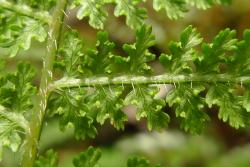- = Hypolepidaceae Pic.Serm., Webbia 24: 705 (1970)
Terrestrial or rupestral ferns. Rhizomes often long-creeping or occasionally short-creeping, usually bearing multicellular hairs, or rarely scales and unicellular hairs (in Histiopteris). Fronds monomorphic, not articulated to rhizome. Laminae usually 2–5-pinnate, rarely 1-pinnate (not NZ), anadromous, herbaceous or coriaceous, usually hairy or rarely glabrous, lacking scales. Veins usually free or rarely anastomosing without free included veinlets. Sori round, or extending laterally, or almost continuous around the lamina margin, superficial or on a slightly raised receptacle, borne on abaxial surface, marginal or submarginal; paraphyses present or absent; indusia ovate and attached at base, or half-cup- or cup-shaped and attached at base and sides, or with a pseudoindusium (formed from the modified recurved lamina margin) sometimes also with an inner indusium, or indusia absent; sporangial maturation mixed. Sporangia with vertical or slightly oblique annulus, usually 64 spores per sporangium. Homosporous; spores monolete or trilete, lacking chlorophyll; perispores variably sculptured.
A family of 11 genera and about 265 species (PPG 1 2016; Shang et al. 2018; Schwartsburd et al. 2020). Kramer (1990) included the Lindsaeoid ferns within the Dennstaedtiaceae, recognising a broad family of about 16 genera. However, molecular analyses (Wolf et al. 1994; Wolf 1995; Der et al. 2009; Lehtonen et al. 2010) showed that the two groups belonged to different clades and should be recognised as the separate families Dennstaedtiaceae and Lindsaeaceae. Smith et al. (2006) listed the genera Blotiella, Coptodipteris, Dennstaedtia, Histiopteris, Hypolepis, Leptolepia, Microlepia, Monachosorum, Oenotrichia, Paesia, and Pteridium within Dennstaedtiaceae, but Yan et al. (2013) reduced the monotypic Coptodipteris to synonymy in Dennstaedtia. Perrie et al. (2015) confirmed that Oenotrichia belongs in the Dennstaedtiaceae, but also showed that Dennstaedtia and Saccoloma are both not monophyletic. Dennstaedtia forms two distinct clades within Dennstaedtiaceae, while Saccoloma forms one clade within Dennstaedtiaceae and one outside. Further work is needed to delimit the genera within the family.
| 1 | Sori discrete, ± round, near lamina margins | 2 |
| Sori ± continuous around lamina margins | 6 | |
| 2 | Adaxial sulci of primary pinnae confluent with rachis; veins of ultimate segments ending in a small marginal sinus; basal pair of pinnae arising at c. 90º to rachis | Hiya |
| Adaxial sulci of primary pinnae not confluent with rachis; veins of ultimate lamina segments never ending in a marginal sinus; basal pair of primary pinnae arising at 20–80º to rachis | 3 | |
| 3 | Sori unprotected, or protected only by inrolled lamina flaps opening away from margin; inner indusia absent; spores monolete | Hypolepis |
| Sori protected by membranous indusia opening towards margin, or by cup-shaped or bivalvate indusia formed from a true inner indusium and modified marginal lamina flap; spores trilete | 4 | |
| 4 | Sori submarginal; indusia ovate, attached to lamina at base with two free lateral margins | Leptolepia |
| Sori marginal or submarginal; indusia cup-shaped, or half cup-shaped and attached to lamina by base and sides | 5 | |
| 5 | Sori marginal; indusia cup-shaped; spores coarsely ridged or reticulate | Dennstaedtia |
| Sori submarginal; indusia half cup-shaped, attached by base and sides to lamina; spores smooth or echinate | Microlepia | |
| 6 | Laminae glabrous, usually glaucous; pinnae sessile; veins reticulate; scales present on rhizome and base of stipe | Histiopteris |
| Laminae hairy, never glaucous; pinnae stalked; veins free; scales absent from rhizome and base of stipe | 7 | |
| 7 | Glandular hairs present on stipes and laminae | Paesia |
| Glandular hairs absent on stipes and laminae | Pteridium |
The Dennstaedtiaceae comprises predominantly terrestrial or scandent ferns with long-creeping rhizomes, mostly 2–5-pinnate laminae bearing multicellular hairs, marginal or submarginal sori that are either discrete or elongated around the lamina edge, and indusia that are either attached at the base and open towards the margin or are formed from the inrolled lamina margin. The sporangia have a vertical annulus. Many of the New Zealand species are opportunist species of disturbed areas.
A worldwide family, mostly tropical but with several species in southern temperate regions and some in the northern temperate zone (Kramer 1990). The greatest diversity is found in the Old World tropics; 29 species in Africa (Roux 2009), 52 in China (Yan et al. 2013), 14 in Australia (Brownsey 1998), and about 25 in the Pacific. One endemic and seven non-endemic genera with 13 species in New Zealand; six endemic, five non-endemic, and two casual species.
| Category | Number |
|---|---|
| Indigenous (Endemic) | 6 |
| Indigenous (Non-endemic) | 5 |
| Exotic: Casual | 2 |
| Total | 13 |




